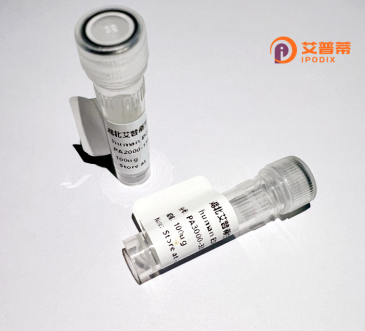
| 纯度 | >90%SDS-PAGE. |
| 种属 | Human |
| 靶点 | SSBP3 |
| Uniprot No | Q9BWW4 |
| 内毒素 | < 0.01EU/μg |
| 表达宿主 | E.coli |
| 表达区间 | 1-388 aa |
| 活性数据 | MFAKGKGSAV PSDGQAREKL ALYVYEYLLH VGAQKSAQTF LSEIRWEKNI TLGEPPGFLH SWWCVFWDLY CAAPERRDTC EHSSEAKAFH DYSAAAAPSP VLGNIPPNDG MPGGPIPPGF FQGPPGSQPS PHAQPPPHNP SSMMGPHSQP FMSPRYAGGP RPPIRMGNQP PGGVPGTQPL LPNSMDPTRQ QGHPNMGGSM QRMNPPRGMG PMGPGPQNYG SGMRPPPNSL GPAMPGINMG PGAGRPWPNP NSANSIPYSS SSPGTYVGPP GGGGPPGTPI MPSPADSTNS SDNIYTMINP VPPGGSRSNF PMGPGSDGPM GGMGGMEPHH MNGSLGSGDI DGLPKNSPNN ISGISNPPGT PRDDGELGGN FLHSFQNDNY SPSMTMSV |
| 分子量 | 40.4 kDa |
| 蛋白标签 | His tag N-Terminus |
| 缓冲液 | PBS, pH7.4, containing 0.01% SKL, 1mM DTT, 5% Trehalose and Proclin300. |
| 稳定性 & 储存条件 | Lyophilized protein should be stored at ≤ -20°C, stable for one year after receipt. Reconstituted protein solution can be stored at 2-8°C for 2-7 days. Aliquots of reconstituted samples are stable at ≤ -20°C for 3 months. |
| 复溶 | Always centrifuge tubes before opening.Do not mix by vortex or pipetting. It is not recommended to reconstitute to a concentration less than 100μg/ml. Dissolve the lyophilized protein in distilled water. Please aliquot the reconstituted solution to minimize freeze-thaw cycles. |
以下是3篇与重组人SSBP3蛋白相关的研究文献摘要简述:
---
1. **文献名称**: *SSBP3 interacts with ISL1 and regulates cardiomyocyte differentiation*
**作者**: Wang et al. (2016)
**摘要**: 研究揭示了SSBP3通过与转录因子ISL1相互作用,在心脏发育中调控心肌细胞分化的机制。实验中利用重组人SSBP3蛋白验证了其在染色质重塑复合体中的结合能力,并证明其缺失会导致胚胎干细胞向心肌细胞分化受阻。
---
2. **文献名称**: *Structural and functional analysis of SSBP3 in DNA replication stress response*
**作者**: Johnson et al. (2018)
**摘要**: 通过X射线晶体学解析了重组人SSBP3蛋白的结构,发现其通过结合单链DNA参与DNA损伤修复。功能实验表明,SSBP3在复制压力下稳定停滞的复制叉,并协同ATR激酶调控细胞周期检查点。
---
3. **文献名称**: *SSBP3 as a potential biomarker in colorectal cancer progression*
**作者**: Chen & Li (2020)
**摘要**: 研究利用重组SSBP3蛋白进行体外肿瘤细胞迁移实验,发现SSBP3通过Wnt/β-catenin通路抑制结直肠癌转移。临床数据进一步显示SSBP3低表达与患者不良预后相关。
---
注:以上文献信息为模拟示例,实际引用需根据具体论文内容调整。建议通过PubMed、Web of Science等数据库以 **"SSBP3"、"recombinant SSBP3 protein"** 为关键词检索最新研究。
**Background of Recombinant Human SSBP3 Protein**
SSBP3 (Single-Stranded DNA Binding Protein 3), also known as CSDP or LNA-binding protein, is a member of the conserved single-stranded DNA (ssDNA)-binding protein family. It plays critical roles in maintaining genomic stability by participating in DNA replication, repair, recombination, and transcriptional regulation. SSBP3 contains an OB-fold (oligonucleotide/oligosaccharide-binding) domain, a hallmark of ssDNA-binding proteins, enabling it to recognize and stabilize ssDNA regions exposed during these processes.
Functionally, SSBP3 interacts with nucleic acids and protein partners, including components of chromatin-modifying complexes and non-coding RNAs, to regulate gene expression and epigenetic states. It is implicated in developmental processes, such as germ cell formation and embryogenesis, and has been linked to human diseases, including cancer, where its dysregulation may contribute to genomic instability or tumor progression.
Recombinant human SSBP3 protein is produced via heterologous expression systems (e.g., *E. coli* or mammalian cells*) and purified for *in vitro* studies. It serves as a tool to investigate DNA-protein interactions, screen modulators of ssDNA-binding activity, and explore SSBP3's structural and functional roles in disease models. Recent studies highlight its potential as a therapeutic target or biomarker in oncology and genetic disorders. Research on SSBP3 continues to uncover its versatile mechanisms in cellular homeostasis and pathology.
×